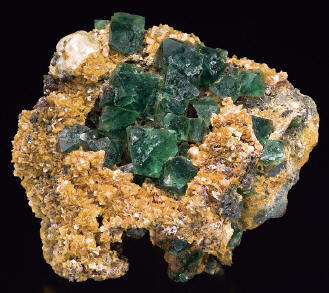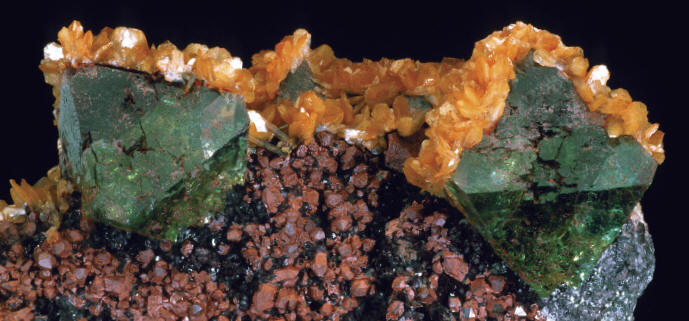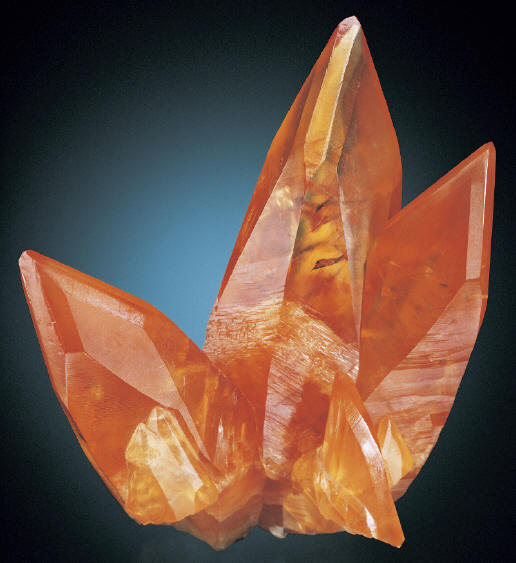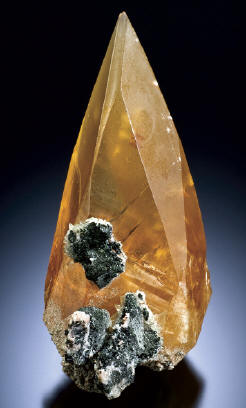
Large specimen of fluorite with stilbite from the Emerald Pocket, 15.7 cm wide. P. Lyckberg specimen. J. Scovil photo
FLUORITE POCKETS OF 1982
In 1982 an exceptional find of emeraldgreen fluorite octahedrons wasmade in a meter sized pocket at the topof a tunnel in the Baron ore body. A secondpocket was later found in the wallnear the discovery pocket. The firstpocket yielded fine large green octahedronsin association with quartz, orange stilbite, chalcopyrite (in complex combspheroidalaggregates), calcite, specularhematite, and chlorite. All together, therewere five fluorite-bearing pockets rangingin size from very small to about twometers long. The best pocket was namedthe Christmas Tree Pocket due to the vibrantcolors of green fluorite with redhematite, white quartz, and golden stilbite. Only a handful of exceptional pieceswere collected up to 15 cm in size with2-3 cm crystals. No more than 20 smallerpieces of good quality were also collected.
The green color of these fluorites isunique, and specimens from these pock pocketsare considered by many to be someof the finest fluorites known!

Fluorite with stilbite and hematite-coated quartz from the Christmas Tree Pocket, largest fluorite is 2.5 cm. P. Lyckberg specimen. J. Scovil photo.
THE FIRST CALCITE POCKET– THE GEM POCKET
During a visit to Malmberget minerKenneth Holmgren’s house in 1988, abroken fragment of gem-clear, scalenohedralcalcite with golden color wasshown to me. The color and quality weremuch better than pieces seen at the Kopparbergshow almost 10 years earlier.
When asked “when, and from whatpart of the mine had it been recovered?”,the miner was a bit reluctant toanswer. Even though the find was ratherrecent, the miner didn’t recall exactlywhere he found the specimen.

Iconic calcite specimen from the Butterfly Pocket, 13.6 cm high. P. Lyckberg specimen. J. Scovil photo.
After a long search among part ofthe 600 km of drivable tunnels in themine, Kenneth showed me a magnetiterock face in a ramp tunnel, and said“there it is!”. I was not convinced of thelocation because there were no calciteveins, pods or even small fragments visible in this part of the tunnel! A smallexcavation had been blasted out towiden the tunnel for parking, erasing allsign of the calcite pocket. Upon detailedexamination, the area didn’t look at allpromising, but who knows what may hide within this black orebody on theother side of the rock wall?

Fluorite with stilbite from the Emerald Pocket, 6.7 cm cm high. J. and G. Spann specimen. J. Scovil photo.
On the left side of the “parking spot”there was a 15-20 cm wide fissure in thesolid magnetite making up the tunnelwall. The vertical fissure was filled withcoarse grained magnetite “sand” andshowed absolutely no signs of crystallization.
Taking turns digging out the magnetite“sand” filling this fracture, thewalls still didn’t show any signs of crystallization.
No magnetite, no apatite, andno calcite seen with more than 1.5 m ofpocket emptied out! We we just about tothe point where we could not reach anyfurther up into this deep pocket, and suddenlya bit of calcite started to show.
A 25x20 cm flower of golden calcite becameexposed... a view never to be forgottenshining in the light of the mininglamp! Imagine seeing flawless, razorsharp, gemmy scalenohedrons, of an unimaginablegolden color and luster contrastedwith the black magnetite ore!
The cluster consisted of approximately30 crystals 5-12 cm in length, the centerhaving a depression i.e. lacking the perfectcrystals. Immediately the pocketwas named “guld/gul kalcit h?lan” (theGem Pocket). Even today these are consideredamong the finest golden calcitescalenohedrons ever found.

Calcite crystal from the Butterfly Twin pocket Pocket, 12.3 cm high. P. Lyckberg specimen. J. Scovil photo.
The difficult position of the calcitecluster necessitated serious work to recoverit complete and undamaged onmatrix. That first evening, only one groupof two crystals and one single crystalwere brought up to the surface. Theycame sliding down a sand slope 2.5 meterinto the pocket while we were working towiden the fissure to facilitate future recoveryof the magnificent specimen.
The mine has to be evacuated eachevening due to huge production blasts atmidnight. In order to protect the minerals,the Gem Pocket was backfilledwith magnetite sand after covering the flower with soft cloths. No traces of recentwork were left. Sadly, I had to leaveat this exciting point in order to attendan obligatory test at the University.







 YueGongAnBei 44051102000467
YueGongAnBei 44051102000467


 |
|